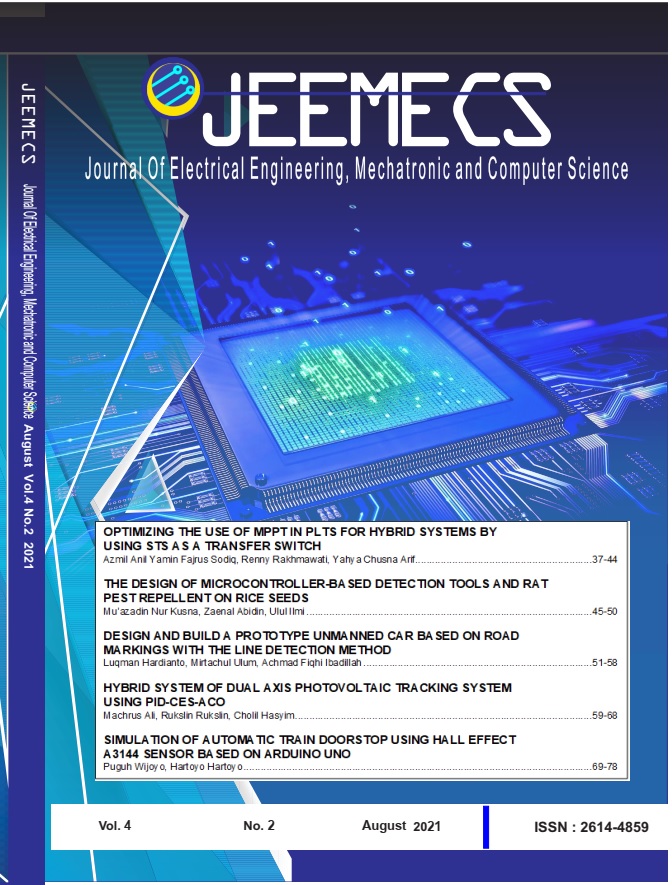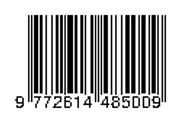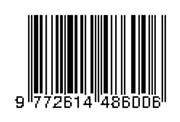The Design of Microcontroller-Based Detection Tools and Rat Pest Repellent on Rice Seeds
DOI:
https://doi.org/10.26905/jeemecs.v4i2.4401Keywords:
Rat, Repellent, Ultrasonic Waves, Camera, IoTAbstract
The control of rat pest in rice nurseries to obtain increased production continues to be done. In an effort to overcome the problem of rat pest various alternative controls have been carried out, both in technical culture, physical mechanics, and chemically. To reduce the undesirable effects of using chemicals to control rat pets, it is necessary to use other alternative rat pets control. Based on these problems, this study conducted various test to create a design that could be used to repel rat pests. The method used includes electrical and systematic design. The steps taken include the sate of literature study then designing, manufacturing hardware and software integrating the system and testing and analyzing the system. Considering these theories, it can find out the programming of microcontrollers, LDR sensors, Cameras, Internet Networks, NE555, Solar Panels, and Accu.This study uses several tests, including testing the LDR sensor, Camera, Internet Network, NE555, Solar Panel and Accu. LDR sensor is functions to detect rat objects, cameras to take video directly, internet network to send video from the microcontroller to the user, NE555 to emit ultrasonic soungd waves to repel rat pests, solar panels as a source of electrical energy, and accu as electrical energy storage that produced solar panels. From all of test above we get results when the LDR Sensor detects a rat then the NE555 will emit ultrasonic waves, then the camera sends video via iot to usser.Downloads
References
Andi, Hari.2018. Alat perangkap hama serangga padi sawah menggunakan cahaya dari tenaga surya. Politeknik Pertanian Negeri Payakumbuh.
Ardiansyah.2019. Perancangan alat pendeteksi hewan pengganggu tanaman kebun menggunakan sensor gerak pir berbasis mikrokontroller. Universitas Islam Negeri Alaudin. Makasar.
Arianto, Alfi.2005. Perancangan alat perangkap tikus elektonis. UIN Sunan Kalijaga Yogyakarta.
Bachri, Affan. 2013. Simulasi Karakteristik Inverter IC 555. Jurnal Teknika
Universitas Islam Lamongan. Unisla Press
Fitriani, I. M., Cendikiawan, A., Kurniawan , R., Aprilia, K. T., & Winarno, T. (2016). Pengusir tikus berbunyi jangkrik pada tanaman padi bertenaga surya. Sentia (p. 111). malang: Politeknik Negri Malang.
https://embeddednesia.com/v1/tutorial-nodemcu-pertemuan-pertama/, Mengenal NodeMCU Pertemuan Pertama. Diakses Pada Tanggal 23 Maret 2020
https://protosupplies.com/product/ne555-timer-module/, Modul NE555. Diakses pada Tanggal 23 Maret 2020
Sugiyono. (2017). Metode penelitian dan pengembangan (Research and Development). Bandung: Alfabeta.
Tarwianti, Susi Endra Rukmana.2017. Prototype Alat pendeteksi dan pengusir tikus pada pembibitan kelapa sawit berbasis arduino uno. Universitas Bengkulu.
Wijanarko, D., Widiastuti, I., & Widya, A. (2017). Gelombang ultrsonik sebagai alat pengusir tikus menggunakan mikrokontroller atmega 8. Jurnal Teknologi Informatika dan Terapan, 67.
Downloads
Additional Files
Published
Issue
Section
License
Our ethic statements are based on COPE’s Best Practice Guidelines for Journal Editors.
Publication decisions
The editor is responsible for deciding which of the articles submitted to the journal should be published.
The editor may be guided by the policies of the journal's editorial board and constrained by such legal requirements as shall then be in force regarding libel, copyright infringement and plagiarism. The editor may confer with other editors or reviewers in making this decision.
Fair play
An editor at any time evaluate manuscripts for their intellectual content without regard to race, gender, sexual orientation, religious belief, ethnic origin, citizenship, or political philosophy of the authors.
Confidentiality
The editor and any editorial staff must not disclose any information about a submitted manuscript to anyone other than the corresponding author, reviewers, potential reviewers, other editorial advisers, and the publisher, as appropriate.
Disclosure and conflicts of interest
Unpublished materials disclosed in a submitted manuscript must not be used in an editor's own research without the express written consent of the author.
Duties of Reviewers
Contribution to Editorial Decisions
Peer review assists the editor in making editorial decisions and through the editorial communications with the author may also assist the author in improving the paper.
Promptness
Any selected referee who feels unqualified to review the research reported in a manuscript or knows that its prompt review will be impossible should notify the editor and excuse himself from the review process.
Confidentiality
Any manuscripts received for review must be treated as confidential documents. They must not be shown to or discussed with others except as authorized by the editor.
Standards of Objectivity
Reviews should be conducted objectively. Personal criticism of the author is inappropriate. Referees should express their views clearly with supporting arguments.
Acknowledgement of Sources
Reviewers should identify relevant published work that has not been cited by the authors. Any statement that an observation, derivation, or argument had been previously reported should be accompanied by the relevant citation. A reviewer should also call to the editor's attention any substantial similarity or overlap between the manuscript under consideration and any other published paper of which they have personal knowledge.
Disclosure and Conflict of Interest
Privileged information or ideas obtained through peer review must be kept confidential and not used for personal advantage. Reviewers should not consider manuscripts in which they have conflicts of interest resulting from competitive, collaborative, or other relationships or connections with any of the authors, companies, or institutions connected to the papers.
Duties of Authors
Reporting standards
Authors of reports of original research should present an accurate account of the work performed as well as an objective discussion of its significance. Underlying data should be represented accurately in the paper. A paper should contain sufficient detail and references to permit others to replicate the work. Fraudulent or knowingly inaccurate statements constitute unethical behavior and are unacceptable.
Originality and Plagiarism
The authors should ensure that they have written entirely original works, and if the authors have used the work and/or words of others that this has been appropriately cited or quoted.
Multiple, Redundant or Concurrent Publication
An author should not in general publish manuscripts describing essentially the same research in more than one journal or primary publication. Submitting the same manuscript to more than one journal concurrently constitutes unethical publishing behaviour and is unacceptable.
Acknowledgement of Sources
Proper acknowledgment of the work of others must always be given. Authors should cite publications that have been influential in determining the nature of the reported work.
Authorship of the Paper
Authorship should be limited to those who have made a significant contribution to the conception, design, execution, or interpretation of the reported study. All those who have made significant contributions should be listed as co-authors. Where there are others who have participated in certain substantive aspects of the research project, they should be acknowledged or listed as contributors.
The corresponding author should ensure that all appropriate co-authors and no inappropriate co-authors are included on the paper, and that all co-authors have seen and approved the final version of the paper and have agreed to its submission for publication.
Disclosure and Conflicts of Interest
All authors should disclose in their manuscript any financial or other substantive conflict of interest that might be construed to influence the results or interpretation of their manuscript. All sources of financial support for the project should be disclosed.
Fundamental errors in published works
When an author discovers a significant error or inaccuracy in his/her own published work, it is the author’s obligation to promptly notify the journal editor or publisher and cooperate with the editor to retract or correct the paper.











